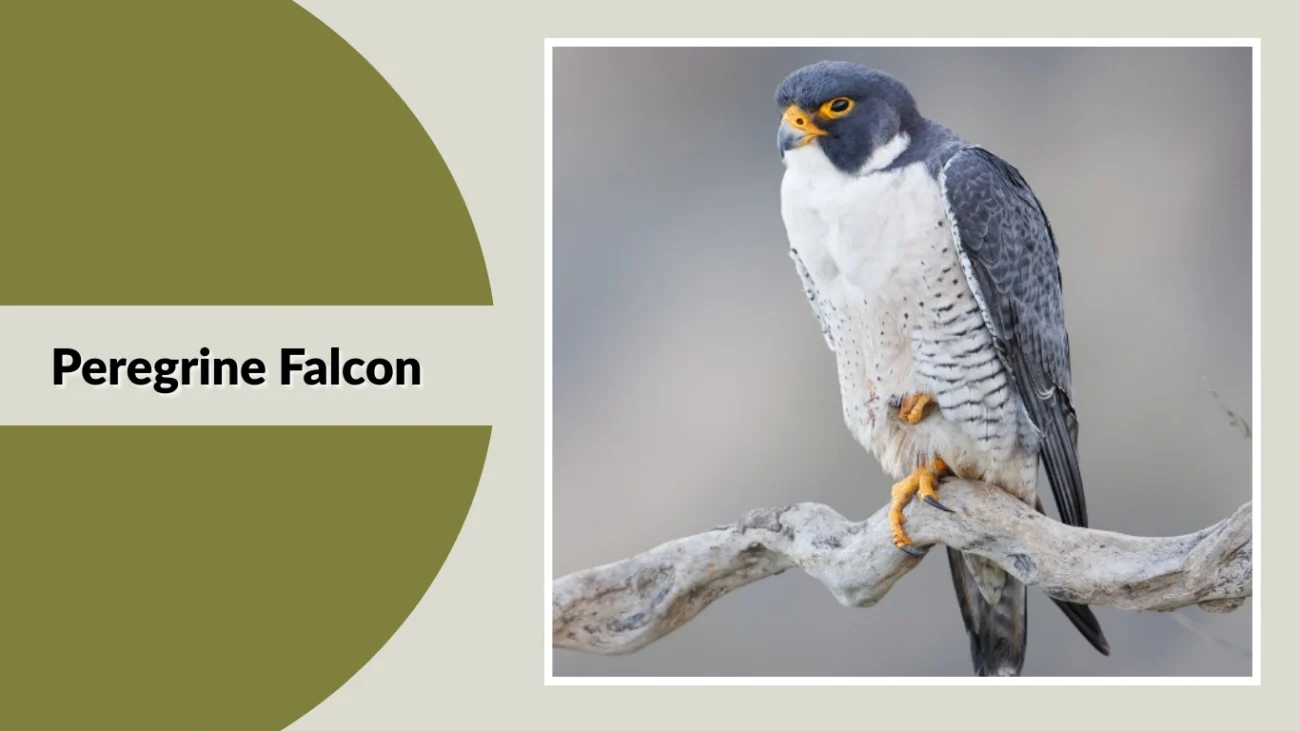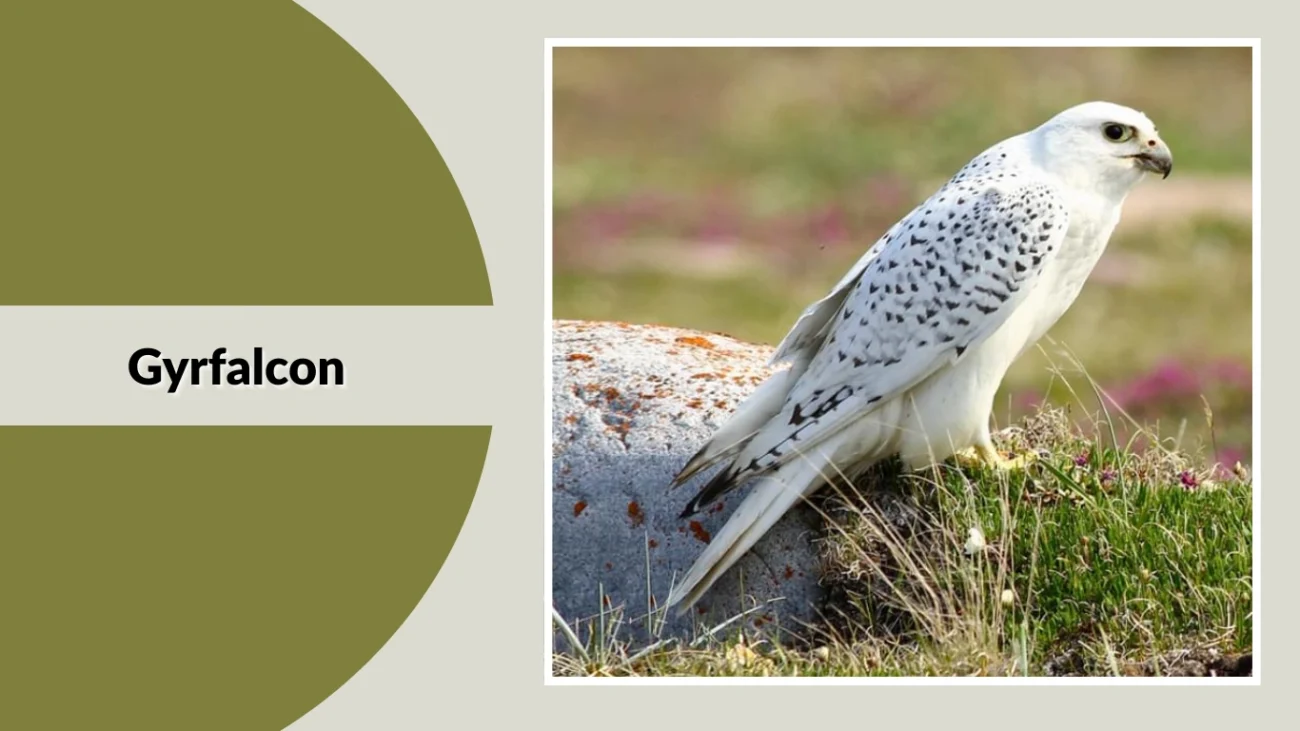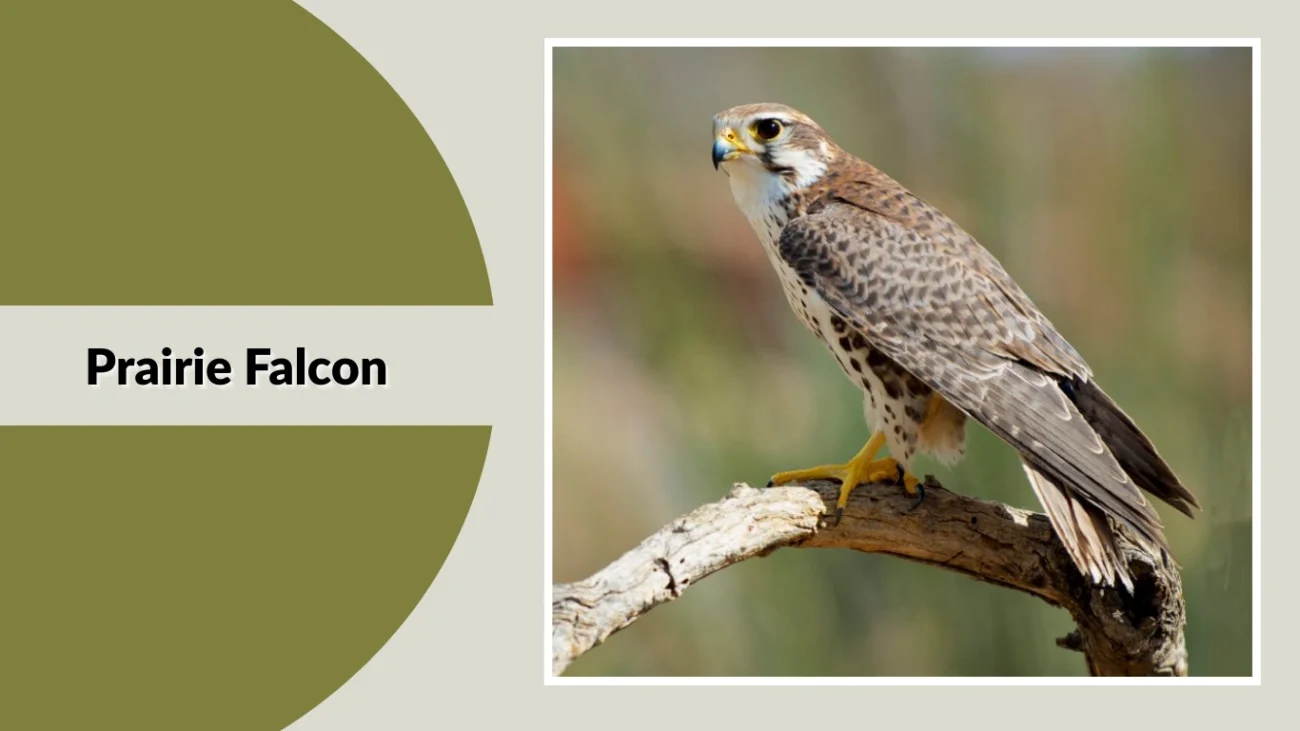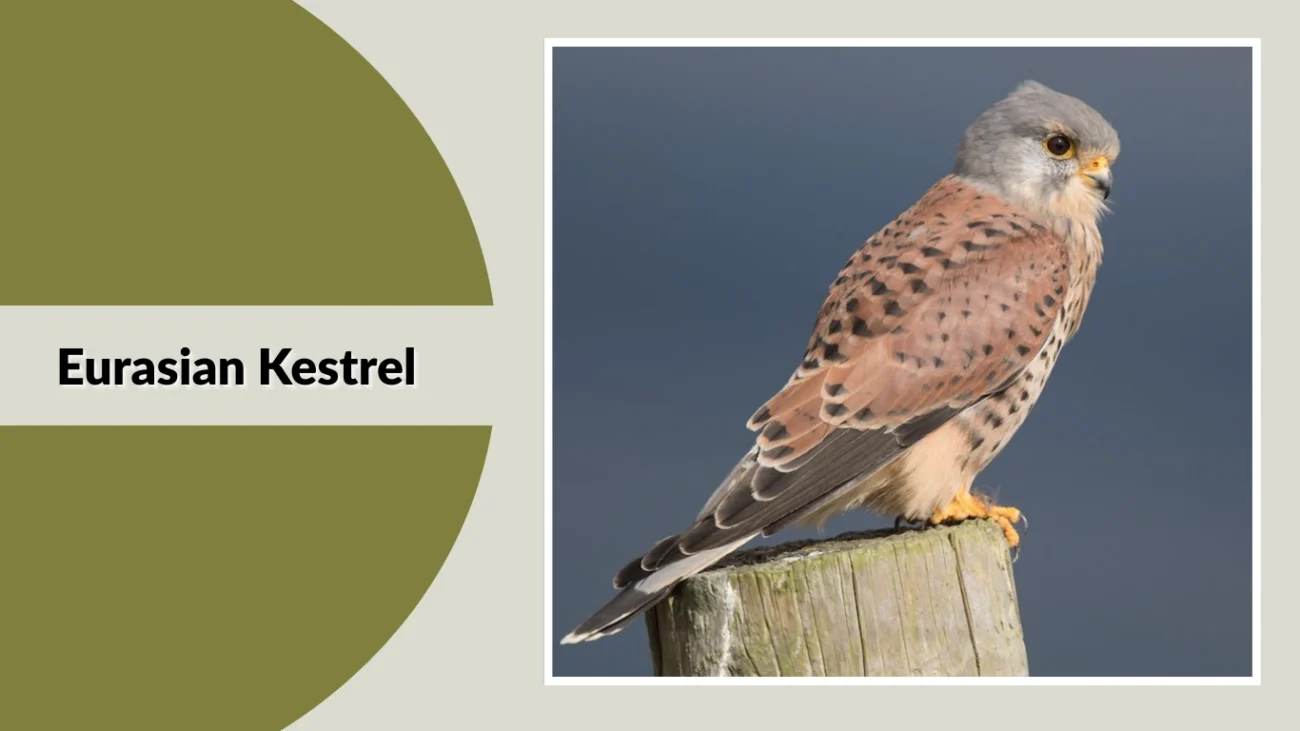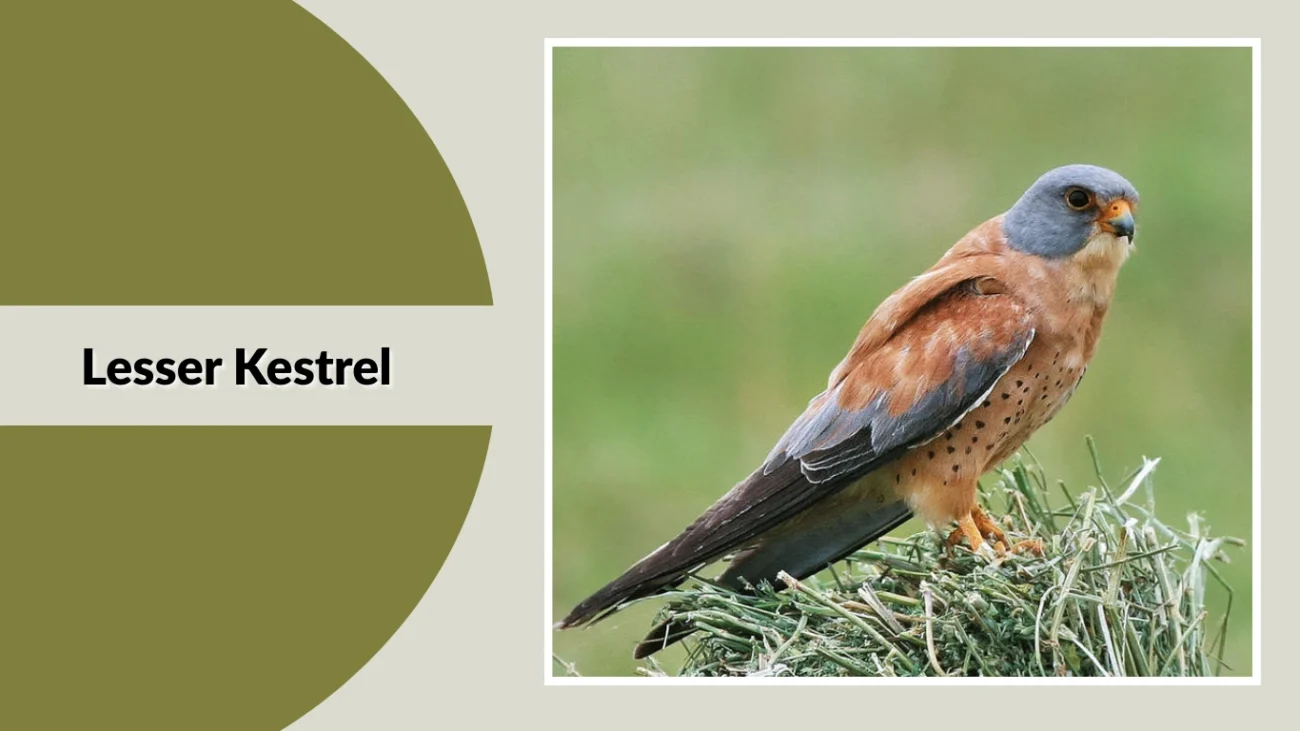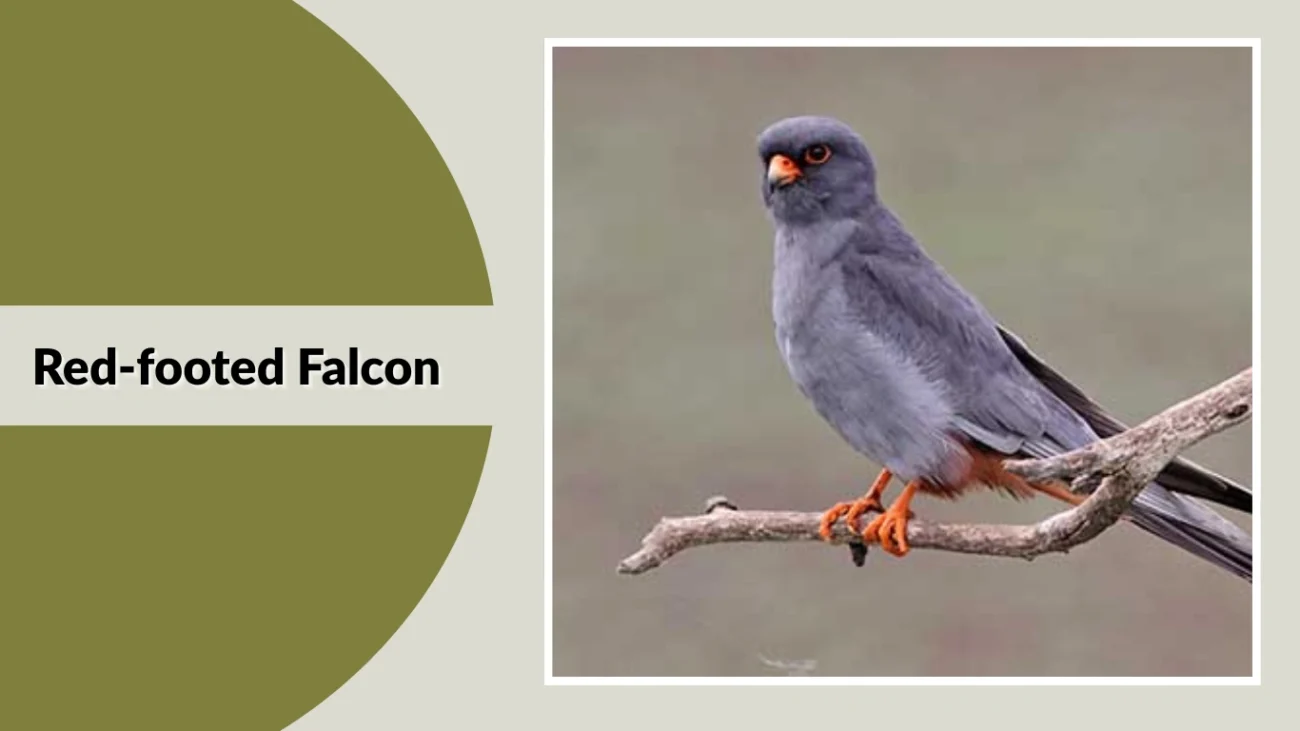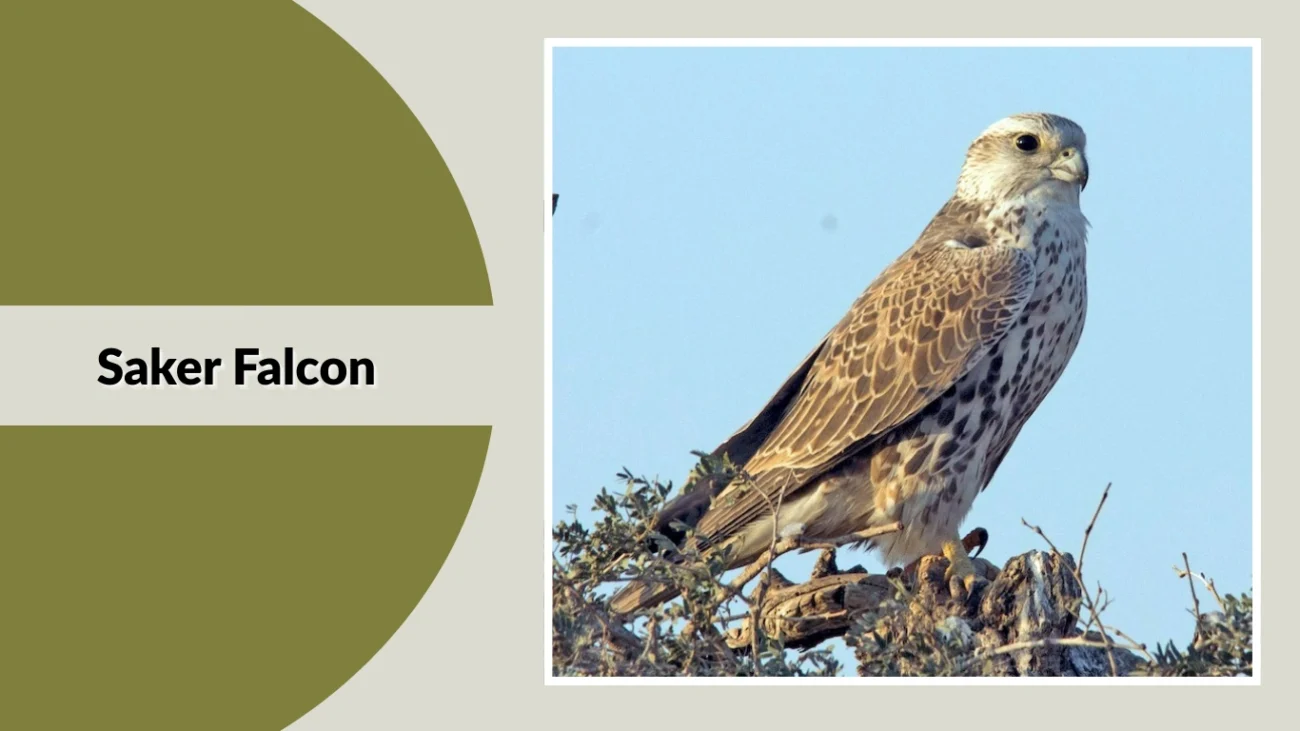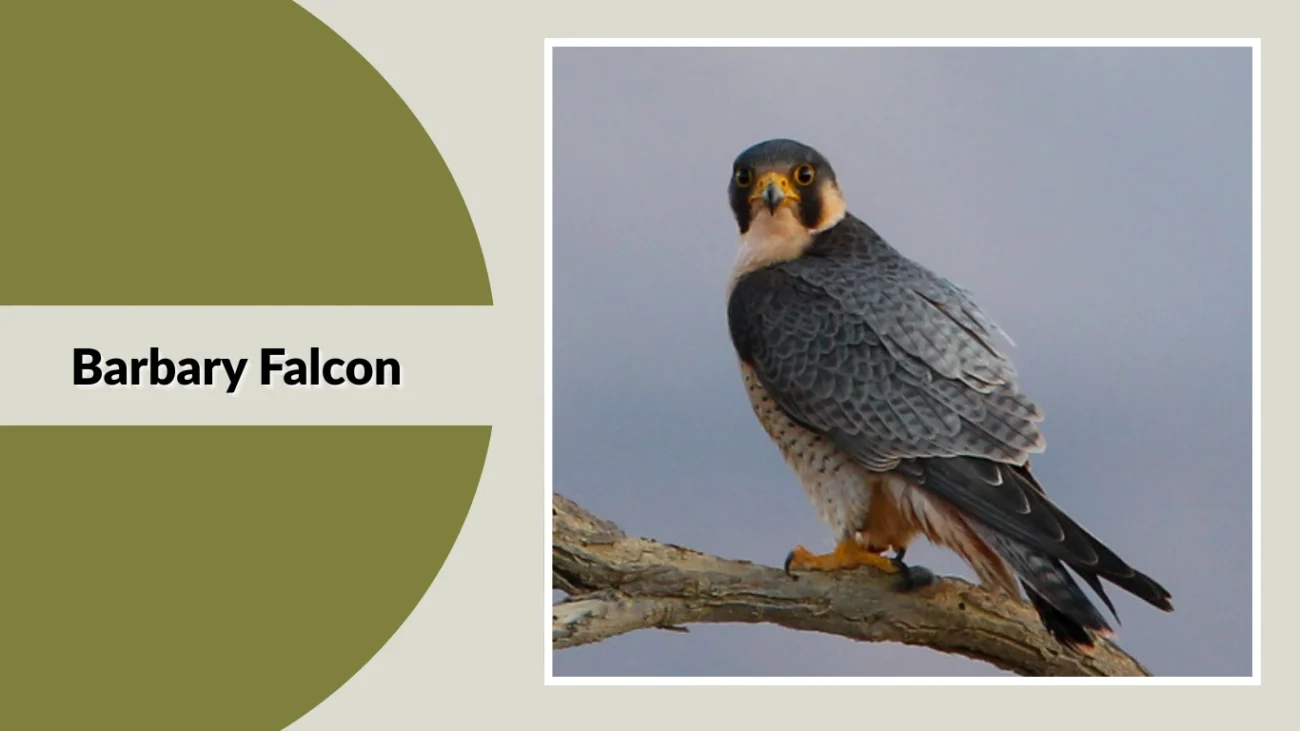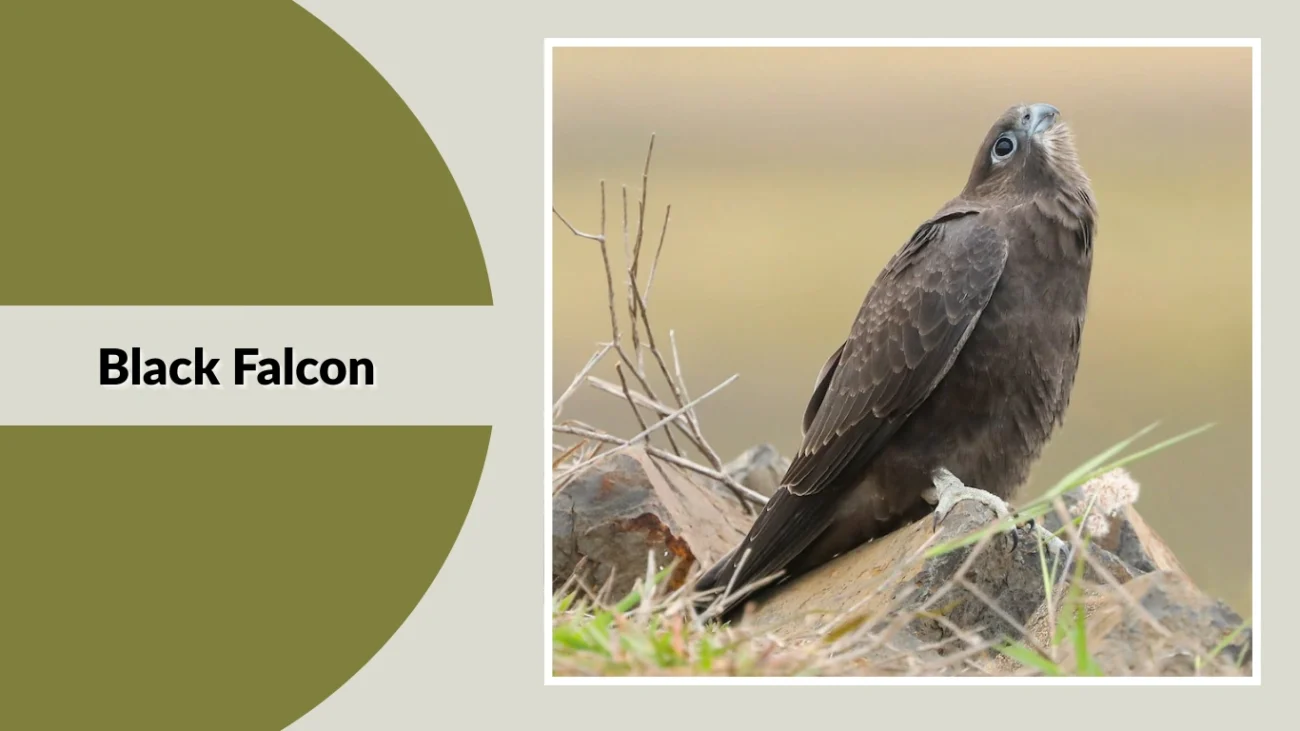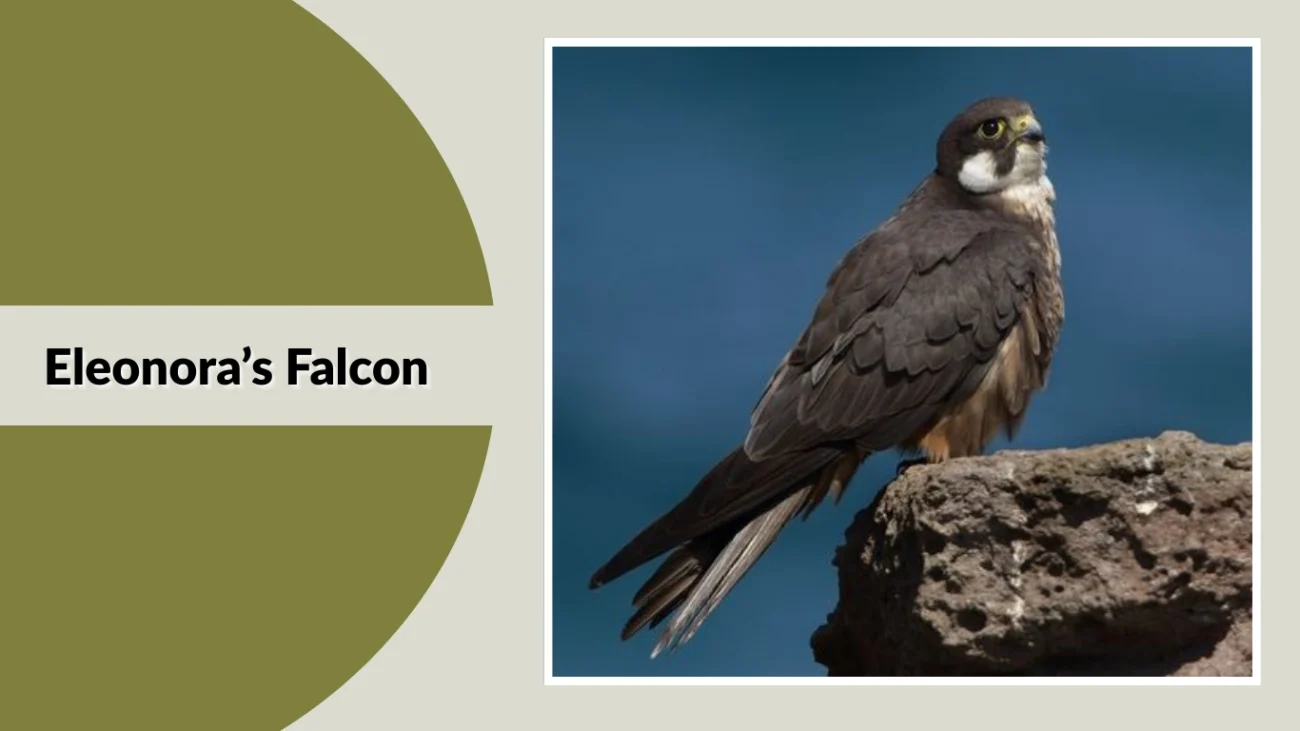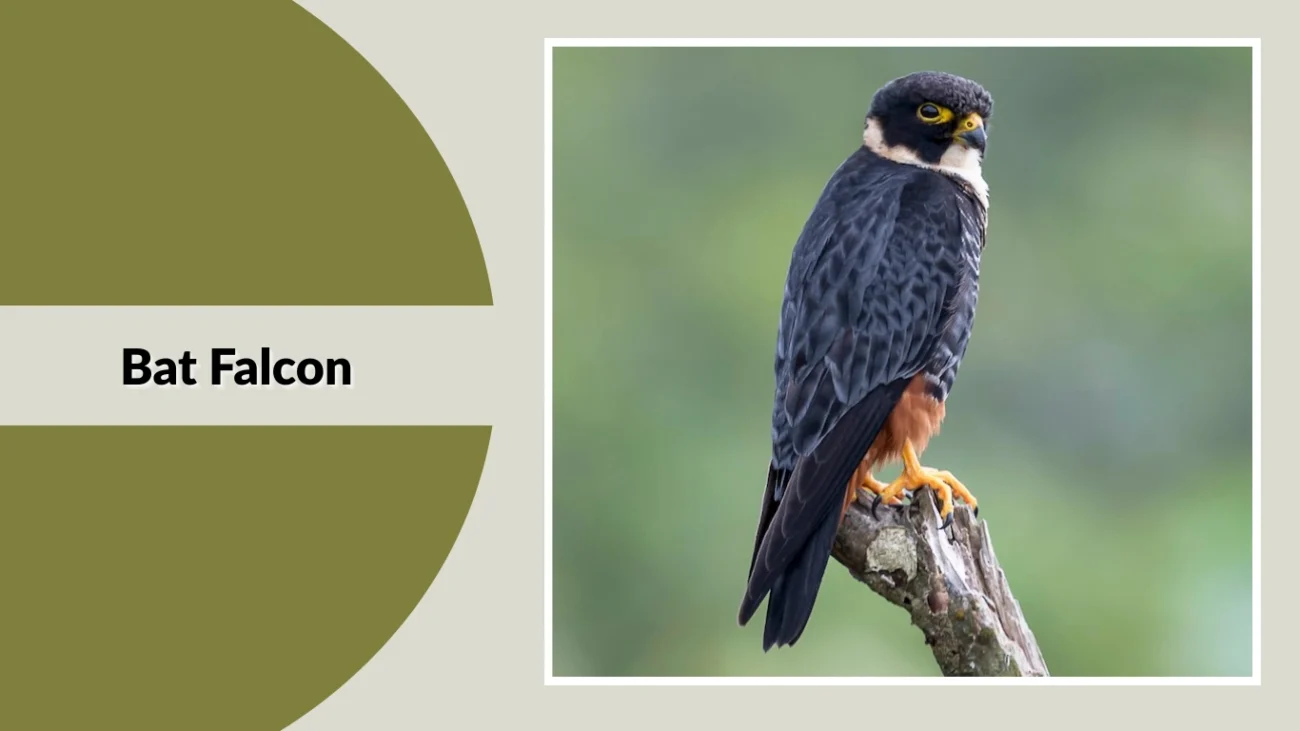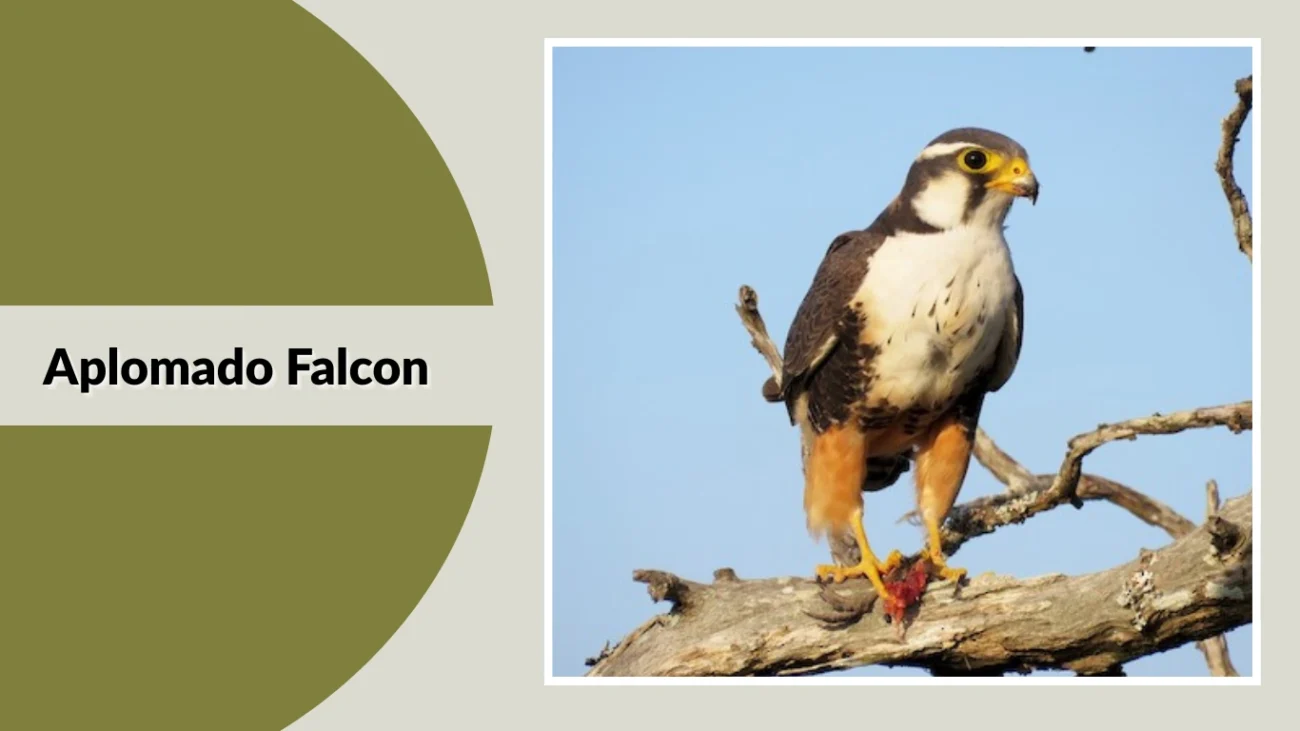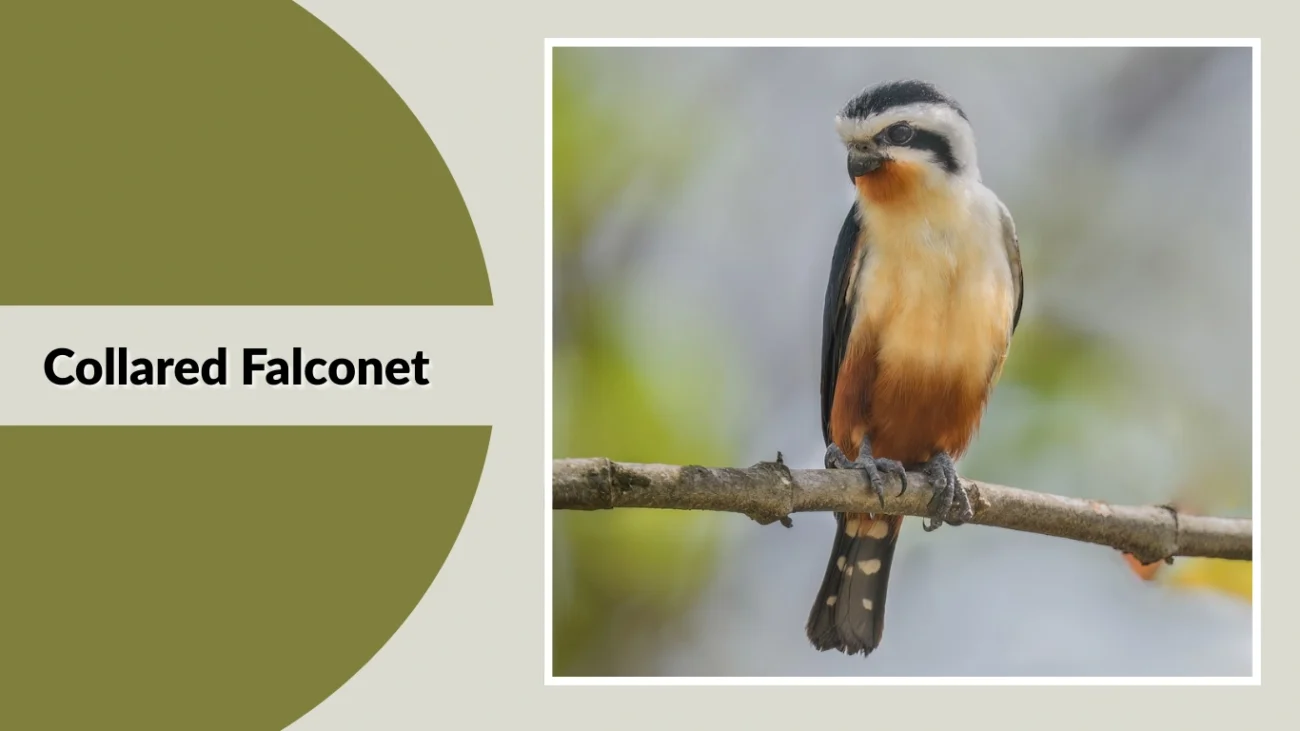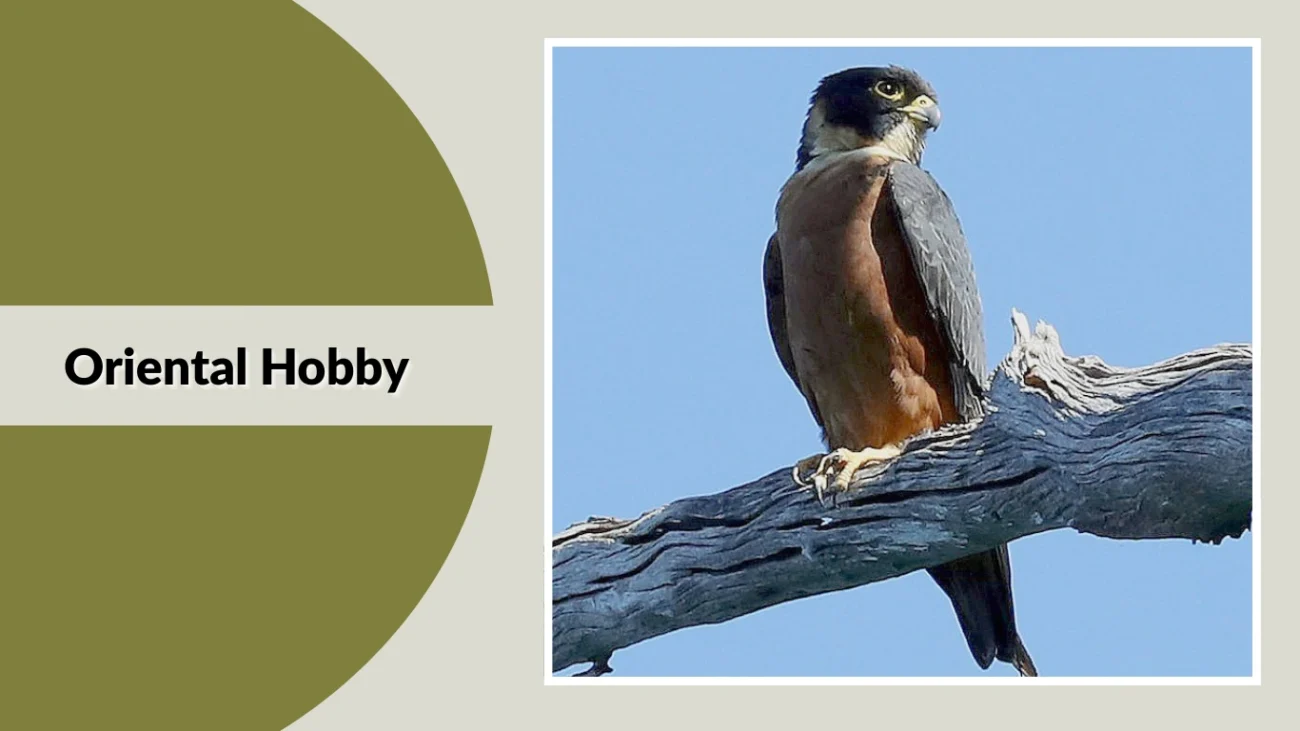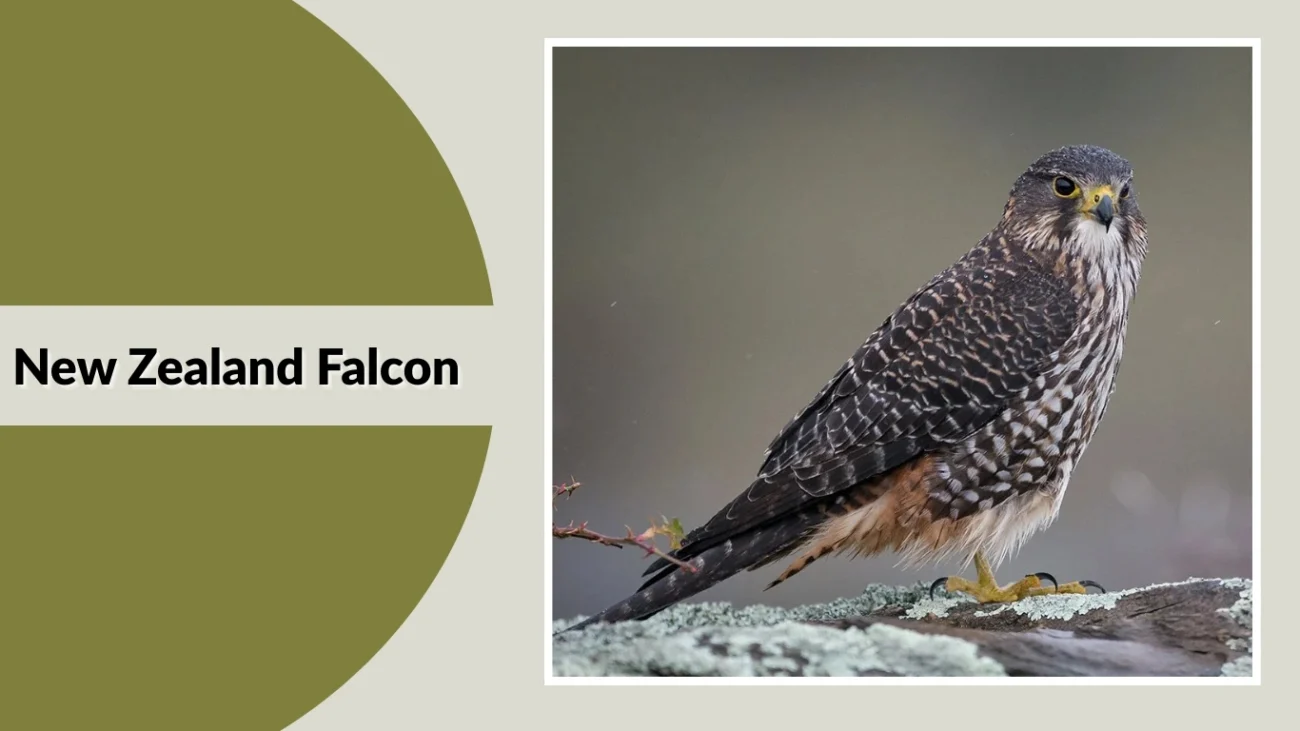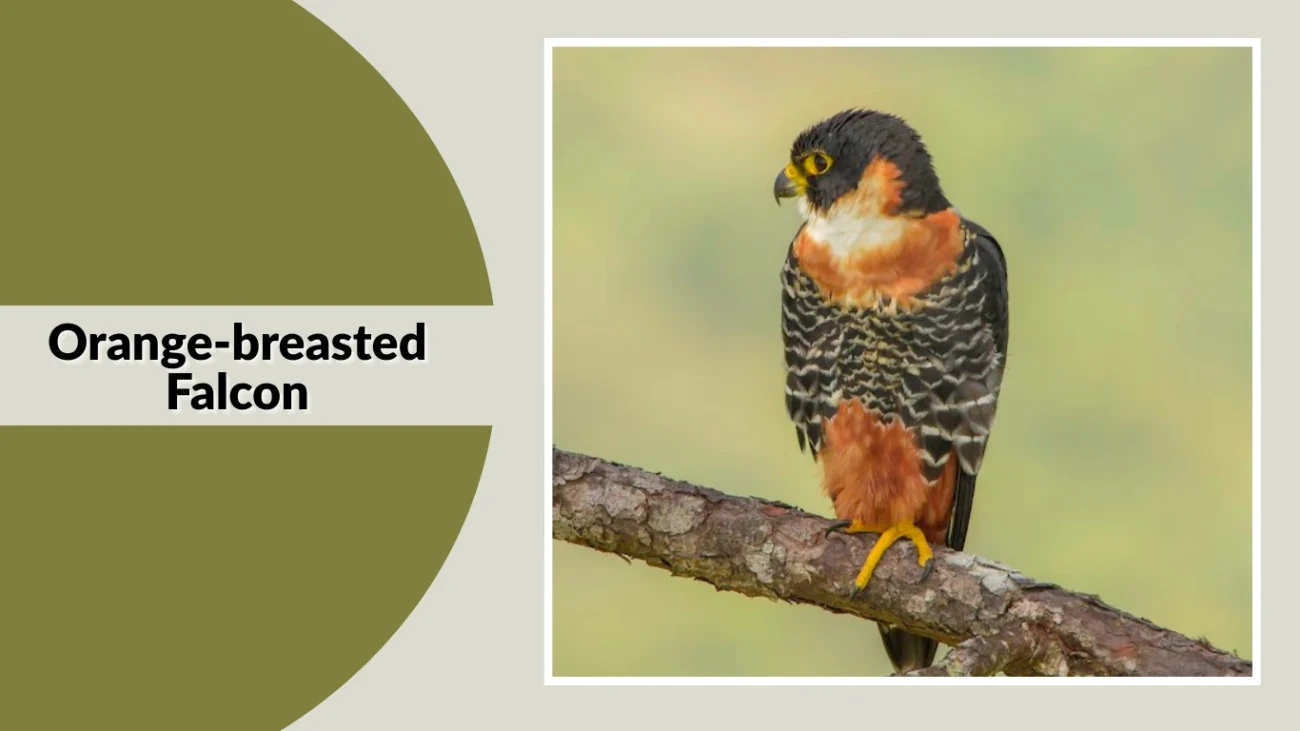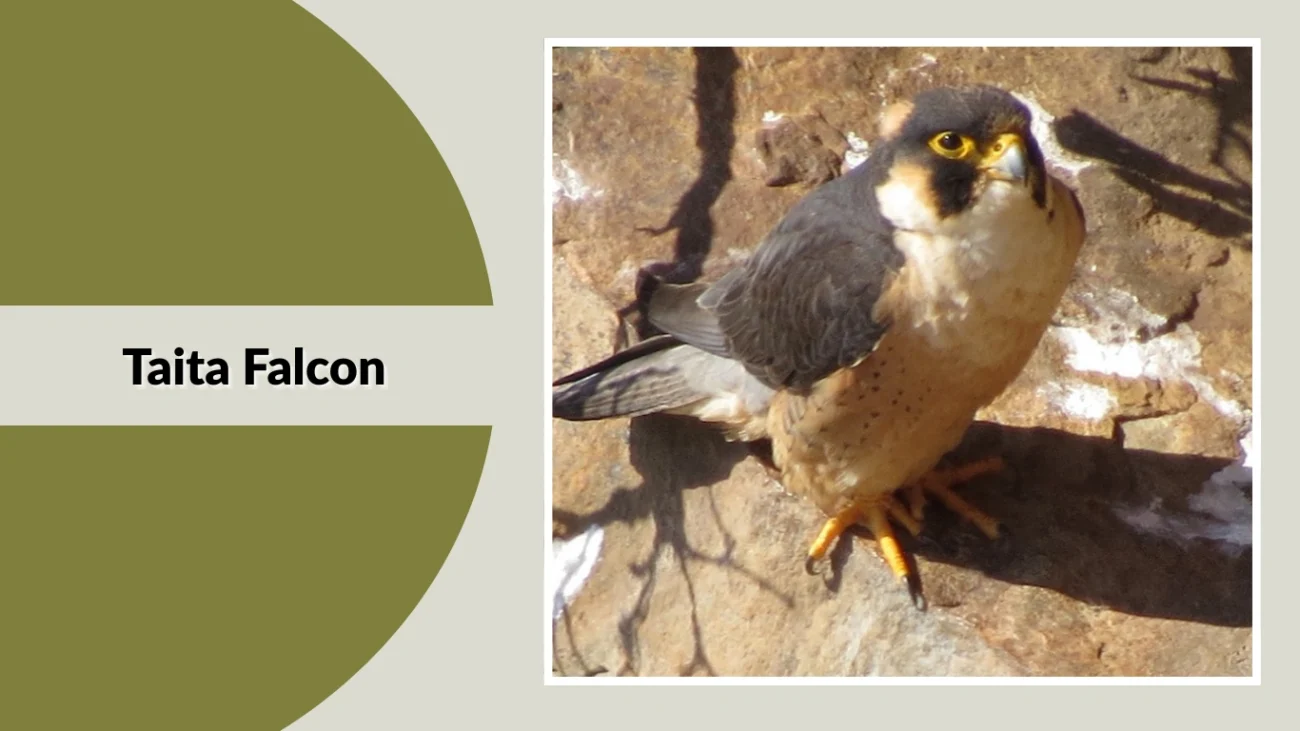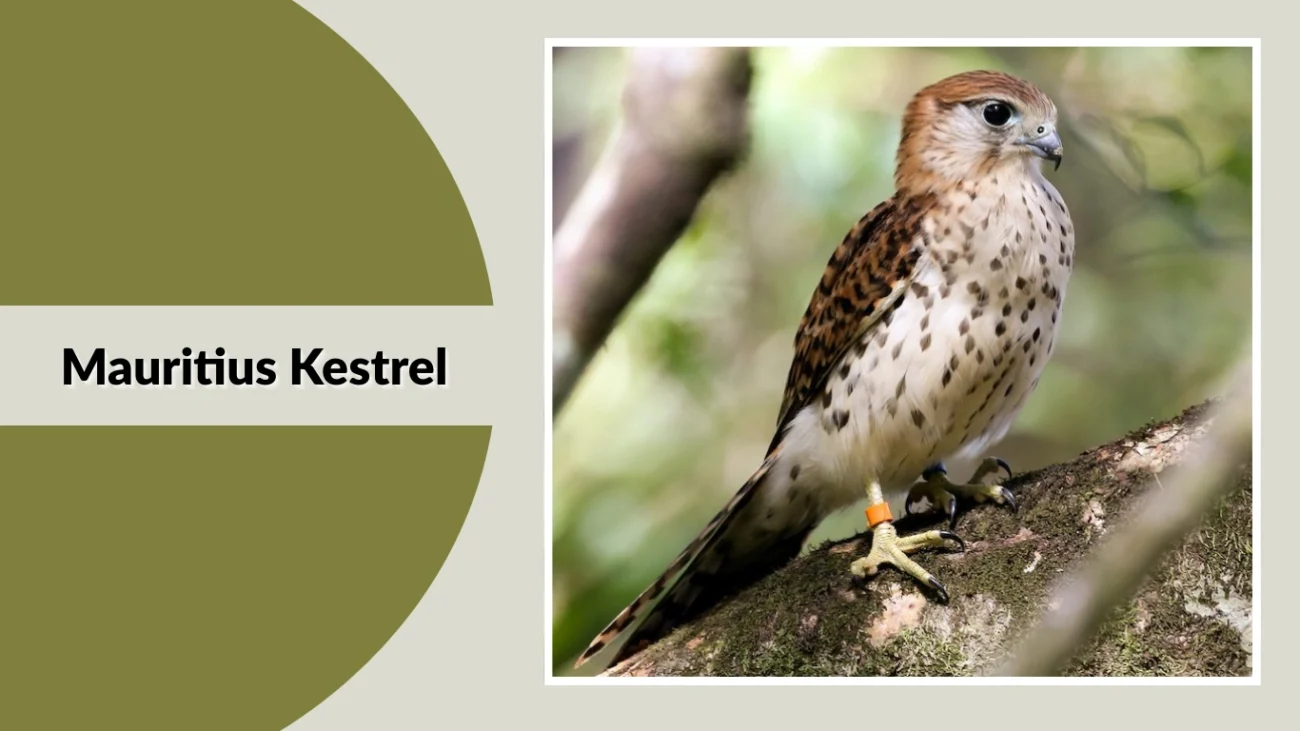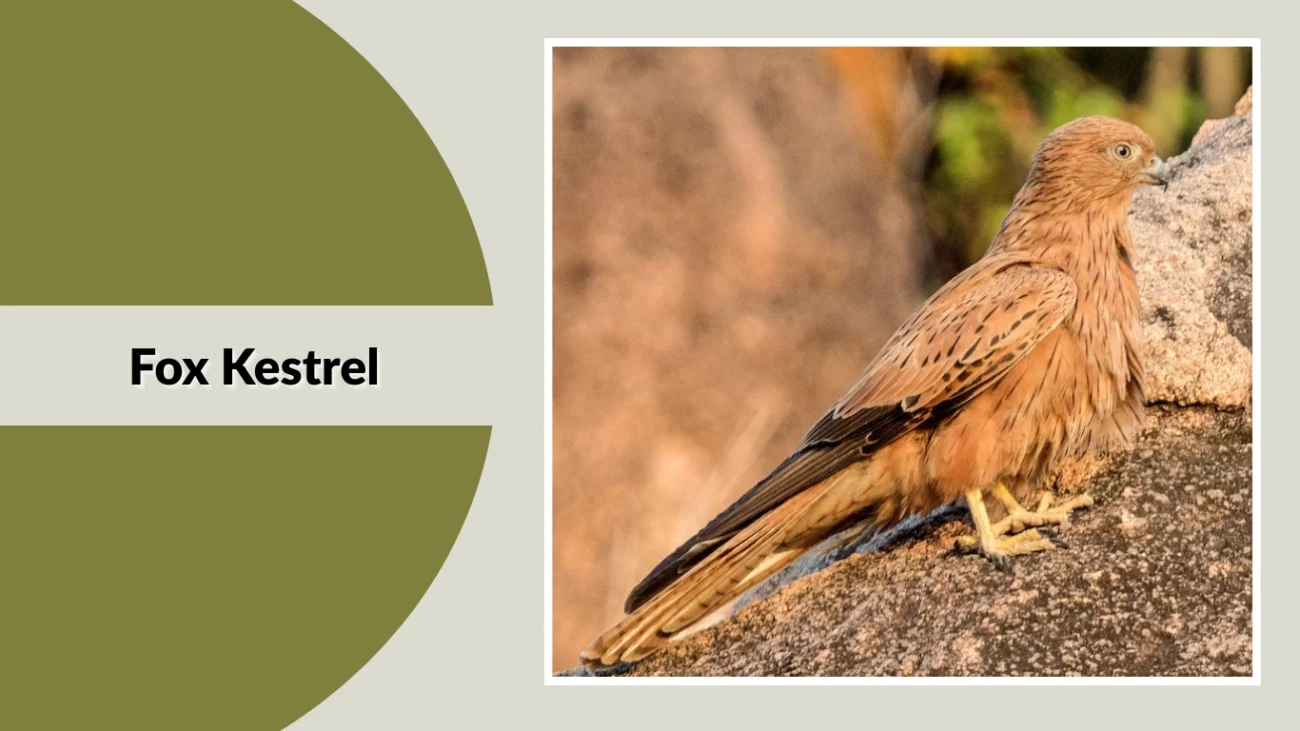Falcons are among the most skilled and diverse birds of prey, admired for their speed, agility, and hunting precision. Found across nearly every continent, these raptors inhabit a wide range of environments, from arid deserts and open grasslands to dense forests and coastal cliffs. In this guide, we explore 27 remarkable falcon species from around the world, detailing their unique physical traits, preferred habitats, and fascinating hunting behaviors.
1. Peregrine Falcon
The peregrine falcon (Falco peregrinus) is one of the most widespread and fastest birds in the world, renowned for its incredible hunting dives, reaching speeds over 200 mph (320 km/h). Found on every continent except Antarctica, it thrives in diverse habitats, from coastal cliffs to skyscrapers in urban areas. Known for its sharp vision and precision hunting, this bird is a top aerial predator.
Identification
- Scientific Name: Falco peregrinus
- Body Size: 34–58 cm (13–23 in) in length
- Wingspan: 74–120 cm (29–47 in)
- Color: Blue-gray back, barred underparts, and distinctive dark “moustache” marks on the face
- Beak: Short, hooked with a yellow cere
- Legs/Feet: Yellow with sharp black talons
Habitat and Distribution
Peregrine falcons inhabit a variety of environments, including coastal cliffs, mountains, open landscapes, and tall urban buildings. They are found globally, from the Arctic tundra to tropical regions, adapting well to both wild and human-modified habitats.
Behavior and Diet
They are powerful hunters, specializing in mid-air strikes on prey such as pigeons, ducks, and shorebirds. Using exceptional eyesight, they spot prey from great distances, stoop in high-speed dives, and strike with precision.
2. Gyrfalcon
The gyrfalcon (Falco rusticolus) is the largest falcon species in the world, known for its power, endurance, and beauty. Native to Arctic and sub-Arctic regions, it thrives in harsh, cold environments. Its plumage varies widely—ranging from pure white to dark gray—which provides excellent camouflage in snowy or rocky landscapes. The gyrfalcon is a highly prized bird in falconry due to its strength and hunting skill.
Identification
- Scientific Name: Falco rusticolus
- Body Size: 48–65 cm (19–26 in) in length
- Wingspan: 110–160 cm (43–63 in)
- Color: Plumage ranges from white, silver, gray, to dark brown, often with speckled patterns
- Beak: Short, hooked with a bluish-gray cere
- Legs/Feet: Yellow with strong black talons
Habitat and Distribution
The gyrfalcon inhabits Arctic tundra, coastal cliffs, and open mountainous regions across North America, Greenland, Iceland, Scandinavia, and Siberia. It prefers areas with abundant prey and nesting sites on high cliffs or rocky outcrops.
Behavior and Diet
This powerful raptor hunts birds such as ptarmigan, ducks, and seabirds, as well as small mammals like hares. It relies on speed, stamina, and surprise attacks, often pursuing prey in extended chases rather than steep dives.
3. Prairie Falcon
The prairie falcon (Falco mexicanus) is a powerful North American raptor adapted to open landscapes such as deserts, prairies, and grasslands. Known for its speed and versatility, it is an agile hunter that thrives in arid regions where prey is abundant. With its pale plumage and fierce hunting style, it is often compared to the peregrine falcon, though it is slightly smaller and more lightly built.
Identification
- Scientific Name: Falco mexicanus
- Body Size: 37–45 cm (15–18 in) in length
- Wingspan: 90–113 cm (35–44 in)
- Color: Brownish upperparts with lighter underparts marked by dark streaks; pale face with a faint moustache mark
- Beak: Short, hooked with a yellow cere
- Legs/Feet: Yellow with sharp talons
Habitat and Distribution
This falcon prefers open, dry environments such as deserts, canyons, and grasslands across western North America, from Canada to central Mexico. It nests on cliff ledges or in rocky outcrops, often near hunting grounds.
Behavior and Diet
Prairie falcons are opportunistic predators, hunting birds like meadowlarks, pigeons, and shorebirds, as well as small mammals such as ground squirrels. They often use surprise attacks, flying low before a rapid ascent to strike prey in mid-air.
4. Merlin
The merlin (Falco columbarius) is a small, fast, and highly agile falcon known for its fierce hunting style and energetic flights. Despite its size, it is a powerful predator that can take down prey nearly its own weight. Often called the “pigeon hawk” in North America, the merlin is admired for its stamina and ability to pursue prey in sustained chases rather than steep dives.
Identification
- Scientific Name: Falco columbarius
- Body Size: 24–33 cm (9.5–13 in) in length
- Wingspan: 50–67 cm (20–26 in)
- Color: Males are slate-gray above with a pale, streaked underside; females and juveniles are brownish above with dense streaking below
- Beak: Short, hooked with a yellow cere
- Legs/Feet: Yellow with sharp black talons
Habitat and Distribution
Merlins breed in northern forests, tundra edges, and open grasslands across North America, Europe, and Asia. In winter, they migrate south to warmer climates, often inhabiting coastal areas, farmlands, and open fields.
Behavior and Diet
This falcon relies on speed and surprise, often flying low before rising to intercept prey mid-flight. Its diet mainly consists of small to medium-sized birds, but it will also hunt large insects and small mammals when available.
5. American Kestrel
The American kestrel (Falco sparverius) is the smallest falcon in North America but one of the most colorful and widespread. Despite its size, it is a bold and efficient predator, capable of taking down prey much larger than itself. Known for its hovering flight while hunting, it is often seen perched on wires or fence posts, scanning open fields for movement.
Identification
- Scientific Name: Falco sparverius
- Body Size: 22–31 cm (8.5–12 in) in length
- Wingspan: 51–61 cm (20–24 in)
- Color: Males have blue-gray wings, a rusty back and tail, and spotted underparts; females are mostly rusty brown with heavy streaking
- Beak: Short, hooked with a yellow cere
- Legs/Feet: Yellow with sharp talons
Habitat and Distribution
American kestrels are highly adaptable, inhabiting grasslands, deserts, farmland, and urban areas. They are found across North and South America, from Alaska and Canada down to Tierra del Fuego.
Behavior and Diet
They hunt by hovering in place or scanning from perches, diving quickly to catch prey. Their diet includes insects, small rodents, reptiles, and small birds, making them versatile hunters in varied environments.
6. Eurasian Kestrel
The Eurasian kestrel (Falco tinnunculus) is one of the most familiar and widespread birds of prey across Europe, Asia, and parts of Africa. Known for its ability to hover mid-air while scanning for prey, it is often seen in open countryside, farmland, and even urban environments. This falcon plays an important role in controlling rodent populations.
Identification
- Scientific Name: Falco tinnunculus
- Body Size: 32–39 cm (12.5–15 in) in length
- Wingspan: 65–82 cm (26–32 in)
- Color: Males have a gray head and tail with a rufous back spotted in black; females are mostly brown with streaked patterns
- Beak: Short, hooked with a yellow cere
- Legs/Feet: Yellow with sharp talons
Habitat and Distribution
Eurasian kestrels inhabit open habitats such as grasslands, agricultural fields, heaths, and moorlands. They are found throughout Europe, Asia, and North Africa, with some populations migrating to warmer regions in winter.
Behavior and Diet
They are skilled hunters, often hovering in place before diving to catch small mammals, birds, and insects. This hovering ability, combined with keen eyesight, makes them highly effective predators in a variety of landscapes.
7. Lesser Kestrel
The lesser kestrel (Falco naumanni) is a small, graceful falcon that closely resembles the Eurasian kestrel but is generally lighter and more colorful. It is known for its sociable nature, often breeding in colonies and hunting in loose groups. This species prefers warmer climates and is a long-distance migrant, traveling between Europe and Africa.
Identification
- Scientific Name: Falco naumanni
- Body Size: 27–33 cm (10.5–13 in) in length
- Wingspan: 63–72 cm (25–28 in)
- Color: Males have blue-gray heads and tails with a reddish-brown back; females are brown with dark streaks; both lack the heavy spotting seen in Eurasian kestrels
- Beak: Short, hooked with a yellow cere
- Legs/Feet: Yellow with fine black talons
Habitat and Distribution
The lesser kestrel inhabits open farmland, grasslands, and semi-arid regions. Breeding populations are concentrated in southern Europe, North Africa, and parts of Asia, with wintering grounds mainly in sub-Saharan Africa.
Behavior and Diet
They hunt primarily insects such as grasshoppers, crickets, and beetles, but will also take small rodents and reptiles. Unlike many other falcons, lesser kestrels are more gregarious, often foraging in groups and roosting communally.
8. Red-footed Falcon
The red-footed falcon (Falco vespertinus) is a small, migratory falcon known for its striking coloration and aerial hunting skills. Males are particularly eye-catching with slate-gray plumage and vivid red legs and feet, while females have a more patterned, buff and gray appearance. This species is often seen in open habitats, hunting insects in agile, acrobatic flight.
Identification
- Scientific Name: Falco vespertinus
- Body Size: 28–34 cm (11–13 in) in length
- Wingspan: 65–75 cm (26–30 in)
- Color: Males are slate-gray with reddish legs and underparts; females are buff and gray with dark streaking on the chest and a pale head
- Beak: Short, hooked with a yellow cere
- Legs/Feet: Bright red with sharp talons
Habitat and Distribution
This species breeds in Eastern Europe and Central Asia, preferring open steppe, farmland, and wetlands. It migrates to southern Africa for the winter, covering long distances during seasonal movements.
Behavior and Diet
Red-footed falcons feed mainly on large insects such as locusts, dragonflies, and beetles, but will also take small birds and rodents when available. They are highly social, often roosting and hunting in flocks during migration.
9. Amur Falcon
The Amur falcon (Falco amurensis) is a small, long-distance migratory falcon famous for one of the most remarkable migration journeys of any bird of prey. Each year, it travels from breeding grounds in East Asia to wintering areas in southern Africa, covering thousands of kilometers and crossing the Indian Ocean. During migration, these falcons are often seen in large flocks, creating spectacular aerial displays.
Identification
- Scientific Name: Falco amurensis
- Body Size: 27–30 cm (10.5–12 in) in length
- Wingspan: 63–71 cm (25–28 in)
- Color: Males are dark gray with reddish legs and vent; females are brown with streaked underparts and a pale head
- Beak: Short, hooked with a yellow cere
- Legs/Feet: Bright red with fine black talons
Habitat and Distribution
They breed in southeastern Siberia, northern China, and Mongolia, preferring open woodlands and farmlands near wetlands. Their wintering grounds are in southern Africa, and they stop in northeastern India and other regions along the migration route.
Behavior and Diet
Amur falcons feed mainly on insects, especially termites, dragonflies, and locusts, often catching them in mid-air. They are highly social during migration, roosting in huge communal flocks and feeding in large groups, especially during stopovers.
10. Saker Falcon
The saker falcon (Falco cherrug) is a large, powerful falcon renowned for its strength, speed, and versatility as a hunter. It is one of the most prized birds in traditional falconry, especially in the Middle East, due to its impressive size and ability to take down larger prey. Adapted to open landscapes, the saker is a formidable predator with a commanding presence in the skies.
Identification
- Scientific Name: Falco cherrug
- Body Size: 45–57 cm (18–22 in) in length
- Wingspan: 105–129 cm (41–51 in)
- Color: Plumage varies from pale sandy brown to darker brown, with streaked underparts and a pale head; juveniles are generally darker
- Beak: Short, hooked with a bluish-gray cere
- Legs/Feet: Yellow with strong black talons
Habitat and Distribution
Saker falcons inhabit open plains, deserts, steppes, and mountainous regions across Eastern Europe, Central Asia, and parts of the Middle East. Some populations migrate southward in winter, while others remain year-round in their range.
Behavior and Diet
These falcons hunt a variety of prey, including medium-sized birds such as pigeons and ducks, as well as mammals like hares and ground squirrels. They use both high-speed chases and low surprise attacks, making them adaptable and effective hunters.
11. Lanner Falcon
The lanner falcon (Falco biarmicus) is a medium-to-large falcon known for its speed, agility, and adaptability in hunting. Often seen gliding low over open terrain, it uses both aerial chases and surprise attacks to capture prey. Its striking facial markings and streamlined body make it a favorite among falconers, especially in Africa and parts of the Middle East.
Identification
- Scientific Name: Falco biarmicus
- Body Size: 43–50 cm (17–20 in) in length
- Wingspan: 95–105 cm (37–41 in)
- Color: Grayish to brown upperparts with pale underparts streaked in dark brown; distinct dark moustache stripe on the face
- Beak: Short, hooked with a bluish-gray cere
- Legs/Feet: Yellow with sharp black talons
Habitat and Distribution
Lanner falcons inhabit open grasslands, savannas, deserts, and mountainous regions across Africa, southeastern Europe, and parts of the Middle East. They prefer areas with scattered trees or cliffs for nesting, often near hunting grounds.
Behavior and Diet
They hunt medium-sized birds such as doves, pigeons, and sandgrouse, as well as small mammals and reptiles. Lanners use cooperative hunting when in pairs, with one bird flushing prey toward the other, increasing their hunting success.
12. Barbary Falcon
The Barbary falcon (Falco peregrinus pelegrinoides) is a subspecies of the peregrine falcon, adapted to the arid and semi-arid regions of North Africa, the Middle East, and parts of South Asia. Slightly smaller and paler than the typical peregrine, it is a skilled hunter, often seen in deserts, coastal cliffs, and open plains. Its speed and precision make it a respected bird in traditional falconry.
Identification
- Scientific Name: Falco peregrinus pelegrinoides
- Body Size: 33–39 cm (13–15 in) in length
- Wingspan: 76–98 cm (30–39 in)
- Color: Paler sandy-brown upperparts with reduced dark barring; underparts are cream with light streaks; distinctive dark moustache mark on the face
- Beak: Short, hooked with a yellow cere
- Legs/Feet: Yellow with sharp black talons
Habitat and Distribution
Barbary falcons inhabit desert edges, coastal cliffs, and mountainous regions across North Africa, the Canary Islands, the Arabian Peninsula, and into parts of Pakistan and India. They prefer open landscapes with nearby nesting ledges or cliffs.
Behavior and Diet
They feed mainly on medium-sized birds such as pigeons, doves, and sandgrouse, capturing them in high-speed aerial pursuits. Like peregrines, Barbary falcons use the stoop (steep dive) to strike prey with precision. They are territorial and often remain in their home range year-round.
13. Black Falcon
The black falcon (Falco subniger) is a large, dark-plumaged raptor native to Australia, known for its commanding flight and powerful hunting skills. With its long wings and swift, direct flight, it is often mistaken for a large dark hawk, but its falcon features and hunting style quickly set it apart. It is one of Australia’s most impressive aerial predators, thriving in open country.
Identification
- Scientific Name: Falco subniger
- Body Size: 50–60 cm (20–24 in) in length
- Wingspan: 110–135 cm (43–53 in)
- Color: Overall dark brown to blackish plumage; pale throat in some individuals; long pointed wings and a long tail
- Beak: Short, hooked with a bluish-gray cere
- Legs/Feet: Yellow with strong black talons
Habitat and Distribution
Black falcons inhabit open woodlands, grasslands, and agricultural areas throughout mainland Australia, especially inland regions. They prefer areas with scattered trees for perching and open ground for hunting.
Behavior and Diet
They hunt mainly medium-sized birds such as parrots, pigeons, and ducks, as well as rabbits and other small mammals. Black falcons often pursue prey in direct, fast flights at high altitudes, sometimes working in pairs to increase hunting success.
14. Brown Falcon
The brown falcon (Falco berigora) is a medium-sized raptor native to Australia and nearby islands, recognized for its variable plumage and adaptable hunting style. Unlike many falcons, it often hunts from perches or the ground, making it a versatile predator well-suited to diverse habitats. Its call, a distinctive cackling cry, is often heard before the bird is spotted.
Identification
- Scientific Name: Falco berigora
- Body Size: 40–50 cm (16–20 in) in length
- Wingspan: 88–115 cm (35–45 in)
- Color: Highly variable; ranges from light brown with pale underparts to dark chocolate brown all over; pale face and yellow eye-ring often visible
- Beak: Short, hooked with a bluish-gray cere
- Legs/Feet: Yellow with strong black talons
Habitat and Distribution
Brown falcons inhabit open woodlands, grasslands, farmland, and coastal plains across mainland Australia, Tasmania, and parts of Papua New Guinea. They favor areas with scattered trees or fence posts for perching.
Behavior and Diet
They hunt a wide range of prey, including small mammals, birds, reptiles, and large insects. Brown falcons often perch and scan for movement before swooping down, but they also engage in low, direct flights to surprise prey. They are known for their adaptability and opportunistic feeding habits.
15. Australian Hobby
The Australian hobby (Falco longipennis), also known as the little falcon, is a sleek, fast-flying raptor found throughout Australia. It is admired for its agile aerial maneuvers and ability to catch prey mid-flight, often performing spectacular chases. Although smaller than many falcons, it is an efficient and skillful hunter, especially of birds and large insects.
Identification
- Scientific Name: Falco longipennis
- Body Size: 30–36 cm (12–14 in) in length
- Wingspan: 76–98 cm (30–39 in)
- Color: Dark slate-gray upperparts with rufous underparts streaked in black; pale throat and cheeks with a narrow dark moustache stripe
- Beak: Short, hooked with a bluish-gray cere
- Legs/Feet: Yellow with sharp black talons
Habitat and Distribution
Australian hobbies inhabit open woodlands, grasslands, farmlands, and urban areas across mainland Australia, Tasmania, and southern New Guinea. They prefer areas with open skies for hunting and scattered tall trees for perching.
Behavior and Diet
They feed mainly on small birds, bats, and large flying insects such as dragonflies. Australian hobbies often hunt at dawn or dusk, using swift, acrobatic flight to intercept prey mid-air. They are solitary or found in pairs, with a reputation for precision and speed in their hunting style.
16. Eleonora’s Falcon
Eleonora’s falcon (Falco eleonorae) is a medium-sized migratory falcon celebrated for its unique breeding strategy, which coincides with the autumn migration of small birds. This allows the species to take advantage of abundant prey for feeding their young. Known for its elegant flight and two distinct color morphs, it breeds mainly on Mediterranean islands before migrating to Madagascar for the winter.
Identification
- Scientific Name: Falco eleonorae
- Body Size: 36–42 cm (14–16.5 in) in length
- Wingspan: 87–104 cm (34–41 in)
- Color: Two morphs—light morph with brown upperparts and pale underparts, and dark morph with overall sooty-brown plumage; both have long, pointed wings and a slender body
- Beak: Short, hooked with a yellow cere
- Legs/Feet: Yellow with sharp black talons
Habitat and Distribution
This species breeds on rocky Mediterranean islands, often nesting on cliffs or steep coastal slopes. After breeding, it migrates to Madagascar and nearby islands, traveling thousands of kilometers across Africa and the Indian Ocean.
Behavior and Diet
Eleonora’s falcons feed mainly on migrating songbirds during the breeding season, catching them in agile mid-air pursuits. Outside the breeding period, they also hunt large insects. Their delayed breeding—late summer into autumn—is an unusual strategy among raptors, perfectly timed to match the peak of southbound bird migration.
17. Bat Falcon
The bat falcon (Falco rufigularis) is a small, compact falcon native to the Americas, named for its habit of hunting bats during twilight. Despite its size, it is a bold and fast predator with striking plumage, making it a favorite sight among birdwatchers. It often perches conspicuously before launching swift aerial pursuits.
Identification
- Scientific Name: Falco rufigularis
- Body Size: 23–30 cm (9–12 in) in length
- Wingspan: 50–60 cm (20–24 in)
- Color: Glossy black upperparts, white throat and upper chest, and rich rufous belly and thighs; dark facial mask with a pale cheek patch
- Beak: Short, hooked with a yellow cere
- Legs/Feet: Bright yellow with sharp black talons
Habitat and Distribution
Bat falcons inhabit tropical and subtropical forests, edges, and open woodlands from Mexico through Central America to much of South America. They are often seen near rivers, clearings, and forested slopes where prey is abundant.
Behavior and Diet
They hunt primarily small birds, large insects, and bats, often at dawn or dusk. Bat falcons use fast, direct flights to catch prey in mid-air, sometimes making long chases. Their habit of targeting bats as they emerge from roosts gives them their distinctive name.
18. Aplomado Falcon
The aplomado falcon (Falco femoralis) is a slender, long-winged falcon with striking plumage and an elegant, powerful flight. Known for its cooperative hunting and agility, it thrives in open habitats where it can chase prey in fast, direct pursuits. Once rare in parts of its range, conservation programs have helped restore populations in North America.
Identification
- Scientific Name: Falco femoralis
- Body Size: 38–43 cm (15–17 in) in length
- Wingspan: 89–102 cm (35–40 in)
- Color: Slate-gray upperparts, white face with bold black moustache marks, white throat, and rufous underparts with a dark belly band
- Beak: Short, hooked with a yellow cere
- Legs/Feet: Bright yellow with sharp black talons
Habitat and Distribution
The aplomado falcon inhabits grasslands, savannas, marsh edges, and open scrubland from the southwestern United States through Mexico, Central America, and into South America. Reintroduction efforts have brought them back to some regions where they had disappeared.
Behavior and Diet
This falcon hunts mostly medium-sized birds, insects, and small mammals, often working in pairs to flush and capture prey. Known for its speed and maneuverability, it chases quarry in open air and rarely uses the high-speed stoop of peregrines, relying instead on sustained pursuit.
19. Collared Falconet
The collared falconet (Microhierax caerulescens) is one of the smallest birds of prey in the world, yet it is a fierce and capable hunter. Despite its tiny size, it has the classic falcon shape—sharp wings, hooked beak, and strong talons—making it an efficient predator of small prey. Its striking plumage and bold demeanor make it a standout among raptors.
Identification
- Scientific Name: Microhierax caerulescens
- Body Size: 18–20 cm (7–8 in) in length
- Wingspan: 30–35 cm (12–14 in)
- Color: Black upperparts with white underparts, a bold white collar around the neck, and a black crown and mask; some chestnut coloration on the belly
- Beak: Short, hooked with a bluish-gray cere
- Legs/Feet: Yellow with fine black talons
Habitat and Distribution
Collared falconets inhabit forest edges, clearings, and open wooded areas across the Indian subcontinent, Southeast Asia, and parts of China. They are often found perched high in trees or on exposed branches, scanning for prey.
Behavior and Diet
They feed primarily on insects such as dragonflies, butterflies, and beetles, but will also take small birds and lizards. Collared falconets often hunt from a perch, launching quick aerial sallies to snatch prey before returning to the same spot. Despite their size, they are confident hunters, often seen in small groups.
20. Oriental Hobby
The oriental hobby (Falco severus) is a small, swift falcon with a sleek build and dark, elegant plumage. It is adept at high-speed pursuits, often darting through forests and open skies to capture agile prey. Its compact size and rapid flight make it a challenging bird to observe in the wild, but it is admired for its precision hunting skills.
Identification
- Scientific Name: Falco severus
- Body Size: 27–30 cm (10.5–12 in) in length
- Wingspan: 65–75 cm (26–30 in)
- Color: Dark slate-brown upperparts, rufous underparts with faint streaking, and a pale throat; black facial mask with a narrow white border
- Beak: Short, hooked with a bluish-gray cere
- Legs/Feet: Yellow with sharp black talons
Habitat and Distribution
The oriental hobby inhabits forest edges, wetlands, open woodlands, and farmlands across South and Southeast Asia, from the Indian subcontinent through Indonesia and the Philippines, and into parts of Papua New Guinea.
Behavior and Diet
They hunt primarily small birds, bats, and large insects, often in fast, twisting pursuits. Oriental hobbies are most active in the early morning and late afternoon, using a mix of stealthy approaches and rapid aerial chases to capture prey. They are sometimes seen hunting in pairs, especially during the breeding season.
21. New Zealand Falcon (Kārearea)
The New Zealand falcon (Falco novaeseelandiae), locally known as the kārearea, is a powerful and aggressive raptor endemic to New Zealand. Despite being smaller than many falcons, it is fearless and capable of taking prey larger than itself. The kārearea is a symbol of strength in Māori culture and is known for its remarkable agility in forested and open landscapes alike.
Identification
- Scientific Name: Falco novaeseelandiae
- Body Size: 40–50 cm (16–20 in) in length
- Wingspan: 80–100 cm (31–39 in)
- Color: Dark brown upperparts with lighter, streaked underparts; yellow eye-ring and cere; strong, hooked beak
- Beak: Short, hooked with a bluish-gray cere
- Legs/Feet: Yellow with sharp black talons
Habitat and Distribution
The kārearea inhabits forests, scrublands, farmland, alpine regions, and coastal cliffs throughout New Zealand, including the North Island, South Island, and Stewart Island. It adapts to various altitudes, from lowlands to high mountains.
Behavior and Diet
They hunt birds, insects, and small mammals using rapid, direct flights and surprise attacks. Unlike many falcons, the kārearea often engages in prolonged chases through dense forest canopies, showcasing incredible maneuverability. It is fiercely territorial, especially during breeding season, and will defend its nest vigorously against intruders, including humans.
22. Grey Falcon
The grey falcon (Falco hypoleucos) is one of the rarest and least-studied birds of prey in Australia, admired for its striking pale plumage and graceful flight. Specially adapted to arid and semi-arid environments, it is a master of survival in harsh landscapes, often hunting during cooler parts of the day to avoid extreme heat.
Identification
- Scientific Name: Falco hypoleucos
- Body Size: 30–45 cm (12–18 in) in length
- Wingspan: 85–95 cm (33–37 in)
- Color: Overall pale bluish-gray above with lighter underparts; faint streaking on the chest; yellow eye-ring and cere
- Beak: Short, hooked with a bluish-gray cere
- Legs/Feet: Yellow with sharp black talons
Habitat and Distribution
This species inhabits inland Australia, preferring open plains, grasslands, and lightly timbered areas. It is often found near waterholes, river courses, and sparsely vegetated deserts. Due to its rarity and large home range, sightings are uncommon.
Behavior and Diet
Grey falcons feed mainly on small to medium-sized birds, occasionally taking reptiles and large insects. They often hunt from a perch or during extended gliding flights, striking swiftly at prey. Known for their calm demeanor, they are less aggressive in flight than some other falcons but equally effective hunters.
23. Orange-breasted Falcon
The orange-breasted falcon (Falco deiroleucus) is a rare and powerful raptor of Central and South America, noted for its striking plumage and resemblance to the peregrine falcon. It is an apex predator in its habitat, often seen soaring over tropical forests and river valleys in search of prey. Due to its rarity and elusive nature, sightings are highly prized by birdwatchers.
Identification
- Scientific Name: Falco deiroleucus
- Body Size: 35–45 cm (14–18 in) in length
- Wingspan: 89–102 cm (35–40 in)
- Color: Glossy black head and back, rich orange underparts, white throat and cheeks with a bold black moustache stripe
- Beak: Short, hooked with a bluish-gray cere
- Legs/Feet: Bright yellow with sharp black talons
Habitat and Distribution
This species inhabits tropical and subtropical forests, primarily along river corridors, cliffs, and forest edges. Its range includes parts of Central America, the Amazon Basin, and the eastern slopes of the Andes.
Behavior and Diet
Orange-breasted falcons are agile hunters, specializing in medium-sized birds such as parrots, doves, and swifts. They hunt mainly in open air, using swift and direct chases. Pairs are highly territorial and may use the same nesting cliffs for many years.
24. Taita Falcon
The Taita falcon (Falco fasciinucha) is a small, rare, and highly specialized falcon found mainly in parts of eastern and southern Africa. Known for its preference for rugged, mountainous terrain, this species is elusive and often goes unnoticed despite its striking appearance and swift hunting style. Its rarity and patchy distribution make it one of Africa’s least-studied raptors.
Identification
- Scientific Name: Falco fasciinucha
- Body Size: 23–30 cm (9–12 in) in length
- Wingspan: 50–65 cm (20–26 in)
- Color: Dark slate-gray upperparts, rufous underparts with dark barring, white throat, and bold dark facial markings
- Beak: Short, hooked with a yellow cere
- Legs/Feet: Bright yellow with sharp black talons
Habitat and Distribution
The Taita falcon inhabits rocky cliffs, escarpments, and highland river valleys, often in remote or inaccessible locations. Its range is scattered across countries such as Zimbabwe, Zambia, Malawi, Mozambique, and parts of East Africa.
Behavior and Diet
This species feeds mainly on small to medium-sized birds, which it captures in swift, direct aerial pursuits. It prefers open airspace near cliffs, where it can launch surprise attacks. Taita falcons are territorial and often seen in pairs, with their nesting sites usually on inaccessible cliff ledges.
25. Mauritius Kestrel
The Mauritius kestrel (Falco punctatus) is a small, rare falcon endemic to the island of Mauritius. Once considered the rarest bird of prey in the world, with only a handful of individuals remaining in the 1970s, it has made an extraordinary recovery thanks to intensive conservation efforts. Its story is a symbol of successful wildlife preservation.
Identification
- Scientific Name: Falco punctatus
- Body Size: 26–30 cm (10–12 in) in length
- Wingspan: 45–50 cm (18–20 in)
- Color: Rufous-brown upperparts, pale underparts with dark spots, and a white face with a dark moustache stripe
- Beak: Short, hooked with a bluish-gray cere
- Legs/Feet: Yellow with fine black talons
Habitat and Distribution
This species inhabits the forests, cliffs, and valleys of Mauritius, favoring areas with tall native trees for nesting and open spaces for hunting. Its range is restricted to the island, making it highly vulnerable to habitat loss.
Behavior and Diet
The Mauritius kestrel primarily feeds on small reptiles, especially geckos, but also hunts insects and small birds. It hunts from a perch, making short, rapid flights to capture prey. Due to its isolated range and small population, it remains closely monitored to ensure long-term survival.
26. Dickinson’s Kestrel
Dickinson’s kestrel (Falco dickinsoni) is a small, stocky falcon found in parts of sub-Saharan Africa. Recognized for its soft gray plumage and short, broad wings, it is often seen perched quietly in tall trees, scanning for prey. This kestrel favors warm, tropical habitats and is less migratory than many of its relatives.
Identification
- Scientific Name: Falco dickinsoni
- Body Size: 27–30 cm (10.5–12 in) in length
- Wingspan: 58–68 cm (23–27 in)
- Color: Uniform pale gray upperparts, whitish underparts with fine streaking, and a lighter gray face with a faint moustache mark
- Beak: Short, hooked with a yellow cere
- Legs/Feet: Yellow with fine black talons
Habitat and Distribution
This species inhabits savannas, woodland edges, riverine forests, and palm-dotted landscapes across central, eastern, and southern Africa, including countries such as Zambia, Tanzania, Mozambique, and Malawi. It prefers areas with scattered tall trees for nesting and perching.
Behavior and Diet
Dickinson’s kestrels feed mainly on large insects, small birds, and reptiles. They hunt by scanning from a perch and making short, rapid flights to capture prey. Unlike many kestrels, they do not often hover but rely on quick, direct strikes.
27. Fox Kestrel
The fox kestrel (Falco alopex) is a large, long-winged kestrel native to the savannas and rocky landscapes of Africa. Named for its rich, fox-like coloration, it is one of the less-studied kestrel species but stands out for its graceful soaring and striking appearance. Unlike some smaller kestrels, it often hunts in open airspace and can cover wide areas in search of prey.
Identification
- Scientific Name: Falco alopex
- Body Size: 35–38 cm (14–15 in) in length
- Wingspan: 85–105 cm (33–41 in)
- Color: Rufous-brown upperparts, pale rufous underparts with faint streaking, long pointed wings, and a slightly forked tail; dark moustache stripe is faint or absent
- Beak: Short, hooked with a yellow cere
- Legs/Feet: Yellow with strong black talons
Habitat and Distribution
Fox kestrels are found across the Sahel region of Africa, from Senegal and Mali eastward through Sudan and Ethiopia. They prefer rocky hills, cliffs, and open savannas where thermals allow them to soar with ease.
Behavior and Diet
They hunt mainly small mammals, lizards, and large insects, often scanning from a high perch or soaring before making a swift stoop to capture prey. Fox kestrels are typically solitary or seen in pairs, but may gather in small groups where prey is abundant.


